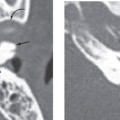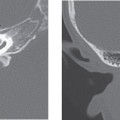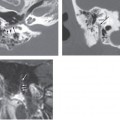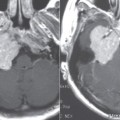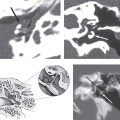CHAPTER 47 Transverse Temporal Bone Fractures
Epidemiology
Transverse fractures are much less common than longitudinal fractures. Longitudinal fractures comprise 70 to 90% of temporal bone fractures, whereas transverse fractures account for approximately 10 to 30%. Specifically, these transverse fractures run perpendicular to the long axis of the petrous temporal bone. In reality, the majority of fractures run oblique to the axis of the petrous bone, and many abnormalities are associated with both types of temporal bone fractures. Transverse fractures usually occur as a result of blunt trauma to the occiput.
Clinical Features
Sensorineural hearing loss and vertigo occur more frequently with transverse fractures of the temporal bones. Sensorineural hearing loss occurs as a result of injury to the osseous labyrinth and cochlear and vestibular structures. In contrast to longitudinal fractures, conductive hearing loss occurs much less frequently because the ossicular chain is often spared. Vertigo can occur due to direct injury to the vestibular nerves or structures, but can also occur as a result of a perilymphatic fistula. Another clinical manifestation of transverse temporal bone fractures is immediate and complete facial paralysis. Delayed manifestations of temporal bone fractures include cerebrospinal fluid (CSF) otorrhea and meningitis.
Pathology
Stay updated, free articles. Join our Telegram channel

Full access? Get Clinical Tree


